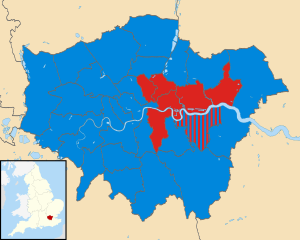1967 Greater London Council election
| ||||||||||||||||||||||||||||||||||
100 councillors 51 seats needed for a majority | ||||||||||||||||||||||||||||||||||
|---|---|---|---|---|---|---|---|---|---|---|---|---|---|---|---|---|---|---|---|---|---|---|---|---|---|---|---|---|---|---|---|---|---|---|
| ||||||||||||||||||||||||||||||||||
 Results by electoral division | ||||||||||||||||||||||||||||||||||
| ||||||||||||||||||||||||||||||||||
The second election to the Greater London Council was held on 13 April 1967, and saw the first Conservative victory for a London-wide authority since 1931.
Electoral arrangements
[edit]New constituencies to be used for elections to Parliament and also for elections to the GLC had not yet been settled, so the London boroughs were used as multi-member 'first past the post' electoral areas. Westminster was joined with the City of London for this purpose. Each electoral area returned between 2 and 4 councillors.
Results
[edit]General election of councillors
[edit]The Conservative Party won a majority of seats at the election.[1]
With an electorate of 5,319,023 and 2,187,789 persons voting, there was a turnout of 41.1%.[2]
Among those defeated in the election were the Labour leader, Bill Fiske in Havering by a Conservative team that included Jeffrey Archer, who was making his entrance into politics, and Peggy Jay in Wandsworth. Other notable politicians who had their first success at this election include Harvey Hinds (Labour, Southwark, later Chief Whip for Ken Livingstone) and Christopher Bland (Conservative, Lewisham, later Chairman of the BBC).[2]
| Party | Votes | Seats | ||||||
|---|---|---|---|---|---|---|---|---|
| Number | % | +/− | Stood | Seats | % | +/− | ||
| Conservative | 1,136,092 | 52.6 | 100 | 82 | 82.0 | |||
| Labour | 732,669 | 34.0 | 100 | 18 | 18.0 | |||
| Liberal | 189,868 | 8.8 | 100 | 0 | 0.0 | |||
| Communist | 65,184 | 3.0 | 38 | 0 | 0.0 | |||
| Independent | 13,229 | 0.6 | 10 | 0 | 0.0 | |||
| Union Movement | 8,146 | 0.4 | 5 | 0 | 0.0 | |||
| Socialist (GB) | 3,695 | 0.2 | New | 14 | 0 | 0.0 | ||
| National Union of Council Tenants | 1,977 | 0.1 | New | 4 | 0 | 0.0 | ||
| National Front | 1,840 | 0.1 | New | 3 | 0 | 0.0 | ||
| John Hampden New Freedom Party | 1,580 | 0.1 | New | 1 | 0 | 0.0 | ||
| Islington Tenants and Ratepayers Political Association | 1,244 | 0.1 | New | 3 | 0 | 0.0 | ||
| Ind. Carnaby Street candidates | 870 | 0.0 | New | 2 | 0 | 0.0 | ||
| Commonwealth Party | 714 | 0.0 | New | 4 | 0 | 0.0 | ||
| European Labour Party | 664 | 0.0 | New | 1 | 0 | 0.0 | ||
Aldermanic election
[edit]In addition to the 100 elected councillors, there were sixteen aldermen on the council. Eight aldermen elected in 1964 continued to serve until 1970 and the other eight retired before the 1967 election. Eight aldermen were elected by the council on 2 May 1967 to serve until 1973.
Aldermen elected in 1967, to retire in 1973:
| Party | Alderman | |
|---|---|---|
| Conservative | David Gilbert Baker[a] | |
| Conservative | Brian Caldwell Cook Batsford[b] | |
| Conservative | Timothy James Bligh[c] | |
| Conservative | Christopher Chataway[d] | |
| Conservative | Timothy Charles Farmer[e] | |
| Conservative | Louis Gluckstein | |
| Conservative | John Oliver Udal | |
| Conservative | Lady Walton (Nellie Margaret Walton)[f] | |
The aldermen divided 10 Conservative and 6 Labour, so that the Conservatives had a total 92 members to 24 for Labour following the aldermanic election.
By-elections 1967–1970
[edit]One of the successful Conservative candidates, Sheila Bradley (Greenwich), was a school nurse for the Inner London Education Authority. It was discovered that this was a disqualifying office, as she was in effect an employee of the GLC (as ILEA was technically a committee of the GLC); she resigned on 24 May prior to the hearing of an election petition. At a by-election on 29 June, Labour gained the seat. There were two further by-elections during the term: on 7 November 1968 the Conservatives held a seat in Bromley after the death of a councillor,[3] and on 12 December of the same year the Conservatives held a seat in Havering after one of their councillors resigned.[4] There were two seats vacant by the end of the term. A Conservative councillor for Harrow died on 8 June 1969, and on 8 January 1970 a Conservative councillor for Hammersmith was disqualified after failing to attend a meeting of the GLC or its committees for six months.
There were two aldermanic by-elections caused by the resignation of Nelly Margaret Walton (Conservative) in 1968 and the death of Timothy James Bligh (Conservative) in 1969. Richard Maddock Brew (Conservative) was elected by the council on 8 October 1968, to serve until 1973. Maurice Stephenson (Conservative) was elected by the council on 29 April 1969, to serve until 1973.
Notes
[edit]References
[edit]- ^ Boothroyd, David. "GLC Election Results Summaries". United Kingdom Election Results. Archived from the original on 1 September 2018. Retrieved 2 September 2023.
- ^ a b "GENERAL ELECTION OF GREATER LONDON COUNCILLORS 13 APRIL 1967" (full results), amazonaws.com/docs/GLC, accessed 2 November 2023
- ^ Boothroyd, David. "Greater London Council Election results: Bromley". United Kingdom Election Results. Archived from the original on 24 March 2016. Retrieved 2 September 2023.
- ^ Boothroyd, David. "Greater London Council Election results: Havering". United Kingdom Election Results. Archived from the original on 24 March 2016. Retrieved 2 September 2023.
